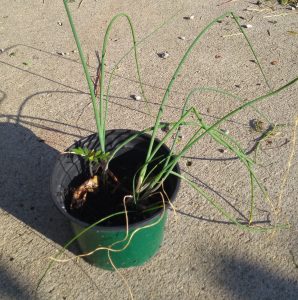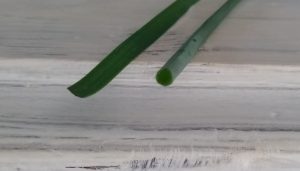
When most people think of chives, they picture the grassy plant with pink, puffball shaped flowers. There are, in fact, two main varieties of chives: Onion chives and garlic chives. Both are members of the Allium family.
Onion chives have the pink flowers and a tubular leaf/stem/greens.

I prefer to use onion chives’ greens when cooking because of the texture and flavor. Plus, I don’t know if it is their tubular shape or not, but chopping onion chives is easier, too.

Garlic chives have white flowers and flat leaves/greens. While I prefer onion chives’ greens, I like garlic chives’ flowers better for garnishes because they aren’t as spicy.


This is my horde of garlic chives that prove that, if you don’t dead head the flowers once they are done with their blooms, they are very good at multiplying. I do love how the abundance of white blooms sort of turns my flower beds into a winter wonder land in mid/late summer.
With their nectar rich flowers, chives are a wonderful plant for pollinators. From what I’ve read, it seems that bees prefer garlic chives and butterflies prefer onion chives. While I can tell you that bees do enjoy garlic chives, as you can see in the pictures, I can’t verify anything about who prefers what. This is mainly because my onion chives are still babies.
One project that I would love to take on is exchanging the grass around my fruiting trees for chives. That will serve a few functions: No need to mow next to the trees anymore, which means I won’t get smacked in the head when my riding mower’s guard rail/beam (that goes over top of the mower and is supposed to protect me if it ever tips over) gets snagged on low branches. The oniony smell from the chives will deter bad bugs like aphids and Japanese beetles (which I’ll talk about more in a later post). Lastly, more chives means more pollinator power!
See:
Happy bees!